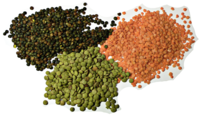
Photo from wikipedia
Sugar beet (Beta vulgaris L.) is a globally important crop for sugar. In May 2019, sugar beet seedlings were observed with wilting, lodging and a few were dead in Billings… Click to show full abstract
Sugar beet (Beta vulgaris L.) is a globally important crop for sugar. In May 2019, sugar beet seedlings were observed with wilting, lodging and a few were dead in Billings (45.7833° N, 108.5007° W), Montana. Symptoms appeared near the soil line as the stem (hypocotyl) turned dark brown to black with characteristic thread-like infections which resembled Pythium root rot. It affected approximately 10% of the growing seedlings. Diseased sugar beet root tissues were excised with a sterile scalpel and small pieces (10 mm²) were surface sterilized with 70 % ethanol for 30 seconds, rinsed twice with autoclaved water, air-dried and transferred to potato dextrose agar (PDA) media amended with pimaricin-vancomycin-PCNB (Conway, 1985). Four plates were incubated at 25° C in the dark (Masago et al., 1977) and two weeks later white, dense colony was observed (Zhang et al., 2018). The terminal smooth, globose oogonia (average 18.5 µm in diameter) and antheridia (average 14.5 × 9.5 µm) extended below the oogonium were observed via VWR N. A. 0.30 microscope. The morphological features of the four isolates were consistent with Pythium ultimum Trow (Watanabe, 2002). Genomic DNAs (NORGEN BIOTEK CORP, Fungi DNA Isolation Kit #26200) of four isolates were used for polymerase chain reaction (PCR) with the ITS6-ITS7 primers (Taheri et al., 2017). Subsequently, PCR products were flushed by E.Z.N.A ®Cycle Pure Kit, OMEGA and four samples were sent for Sanger sequencing to GenScript (GenScript, Piscataway, NJ). The sequences were identical and submitted to GenBank, NCBI (accession no. MN398593). The NCBI Blast analysis showed 100% sequence homology to Pythium ultimum with the following GenBank accessions; KF181451.1, KF181449.1 and AY598657.2. Pathogenicity test was done on sugar beet with the same isolates in the greenhouse. Two week old, pythium culture was mixed with vermiculite and perlite mixer (PRO-MIX FLX) in the plastic trays (24´´ x 15´´× 3˝), (22 °C, 75% Relative Humidity). Sterile water (500 ml/each tray) was added in the mixer to keep the sufficient moisture. Twenty seeds of cv. Hilleshog 4302 were sown in the tray, and the trays were replicated thrice with inoculated and mock treatments. Plants were watered as needed to maintain adequate soil moisture conducive for plant growth and disease development. Seven days of sowing, 50% and 100% germination was observed in the inoculated and control treatments, respectively. At the beginning after the second week, 30% post-emergence damping-off was observed in the inoculated treatments. Diseased seedlings were gently pulled out from the pots where similar infection signs were observed in the sugar beet seedlings as described previously. No incidence of disease was observed in mock-treated seedlings. Consistent reisolation of Pythium ultimum was morphologically and molecularly confirmed from the diseased seedlings, thus fulfilling Koch's postulates. Pythium spp identification is prerequisite to develop effective management of pre and post-emergence damping-off. Pythium ultimum was previously reported in Nebraska to cause sugar beet seed rot and pre-emergence damping-off (Harvenson 2006). To our knowledge, this is the first report of Pythium ultimum causing damping-off on sugar beet in Montana.
Journal Title: Plant disease
Year Published: 2020
Link to full text (if available)
Share on Social Media: Sign Up to like & get
recommendations!